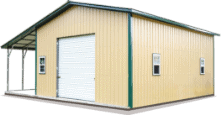TL;DR:
Metal buildings aren’t just about price or size — they’re long-term decisions. Whether you’re dealing with sun, storms, snow, or time itself, this guide breaks down which structures actually hold up, what they’re best used for, and how to avoid expensive mistakes down the road
Section 1: Which Structures Hold Up Best in Each Climate Type?
Which Structures Hold Up Best in Each Climate Type?
When you’re shopping for a metal building—whether it’s a carport, barn, camper shed, or prefab garage—you’re not just buying square footage. You’re buying long-term protection against everything your climate throws at it: sun, wind, rain, humidity, snow, and time.
And while most buildings look good on day one, what really matters is how they hold up five years from now. That’s why matching the right structure to your local weather isn’t optional—it’s essential.
Hot and Dry Climates (High UV and Dust)
Common challenges:
-
Paint fading and material breakdown from intense UV exposure
-
Dust accumulation in poorly ventilated structures
-
Warping or cracking in stored vehicles and RVs
Best building types:
-
Camper carports with UV-reflective roofing
-
Metal barns with ridge vents and proper airflow
-
Insulated enclosed sheds to regulate internal temps
Recommended features:
-
Vertical roof panels (easier dust runoff)
-
Galvalume or powder-coated framing to resist heat damage
-
Side panel extensions for partial shade and wind resistance
Tip: If your RV or camper is sitting through 100+ degree heat, an open carport with extended panels may actually keep it cooler than a closed shed—provided it’s parked under a vertical roof with proper ventilation.
Cold and Snowy Climates
Common challenges:
-
Roof collapse under snow load
-
Frozen door seals and moisture inside sheds
-
Material brittleness in subzero temps
Best building types:
-
A-frame carports with vertical roofs
-
20×20 or larger enclosed metal buildings for snow-rated storage
-
Metal barn buildings with reinforced trusses and certified loads
Recommended features:
-
Minimum 4/12 roof pitch with vertical panels
-
Ground anchoring and wind/snow certification
-
Drip-stop or vapor barrier insulation to prevent condensation
Tip: Don’t just consider square footage—consider load rating. A cheap 20×20 metal carport might work for light rain, but you’ll need a certified vertical roof if your region gets regular snow.
Humid and Stormy Climates (Rain, Hurricanes, Coastal Zones)
Common challenges:
-
Rust and corrosion from salty air
-
Uplift damage from strong winds
-
Water intrusion into poorly sealed buildings
Best building types:
-
Reinforced RV camper carports with enclosed sides
-
Prefab metal buildings with sealed entry points
-
Carports with storage rooms to protect valuables from flooding
Recommended features:
Tip: For areas hit by frequent tropical storms, a partially enclosed carport with wind-rated bracing often performs better than a fully open model—and it’s faster to install than a full garage.
Summary Table: Structure Recommendations by Climate
| Climate Type |
Best Structures |
Key Features to Look For |
| Hot and Dry |
Camper carport, metal barn |
UV resistance, ventilation, side panels |
| Cold and Snowy |
A-frame carport, enclosed barn |
Vertical roof, certified load rating, truss system |
| Humid/Storm-Prone |
RV carport with sides, prefab shed |
Anchors, sealed edges, rust protection |
Why This Matters:
It’s not just about what you’re storing—it’s about where. The same RV that lasts 10 years under a properly designed metal carport in Arizona might get sun-scorched in a year under the wrong setup. In Minnesota, a flat-roof carport can buckle from one heavy snowfall. And in Florida? A badly anchored shed can become airborne.
Choosing the right building isn’t just smart. It’s protective.
Sun vs. Shade — How Long-Term UV Exposure Damages RVs and Campers
If you’ve ever walked out to your camper after a few weeks in the summer sun and noticed cracking, fading, or a musty smell inside — that’s UV damage. It doesn’t just affect paint. It breaks down seals, warps plastic trim, and accelerates interior heat buildup.
And unlike a surprise storm, UV exposure is silent. It happens every single day, whether or not you’re looking. That’s why choosing the right camper carport, shed, or RV cover isn’t about aesthetics. It’s about preservation.
What Does the Sun Actually Do to Your Camper?
Here’s what extended exposure to UV rays and heat can damage:
-
Roof seams and sealants start to dry, crack, and leak
-
Decals and paint fade and peel
-
Plastic trim warps or yellows
-
Tire rubber degrades faster
-
Interior temperatures soar, leading to cracked dashboards and appliances failing over time
-
Mold and mildew develop from trapped humidity after heatwaves
This is especially common with fiberglass or vinyl-roof campers, which are more susceptible to heat-related breakdowns.
How Shade Protects Your Investment
Whether you’re storing a $10K teardrop trailer or a $250K motorhome, sun protection isn’t optional—it’s financial defense. The right carport or shed can extend the life of your rig by years.
Let’s compare the top options:
| Structure Type |
Protection Level |
Best For |
| Open camper carport |
Moderate |
Short-term shade, frequent access |
| Carport with side panels |
High |
Daily protection, good airflow |
| Enclosed camper shed |
Maximum |
Long-term storage, harsh climates |
| Motorhome carport with vertical roof |
High |
Tall vehicles, UV and rain deflection |
Pro tip: A vertical roof structure (vs. horizontal panels) is more effective at shedding heat, rain, and debris — and reduces the long-term warping effects of sun exposure.
Not All Shade Is Equal — Why Cheap Carports Fail
A lot of people think, “Any shade is better than nothing,” but here’s what we’ve seen:
-
Basic aluminum kits without UV coating break down in 2–3 years
-
Low-gauge steel frames rust from inside out when not sealed properly
-
Flat roofs trap heat and water, worsening the very problem they’re meant to solve
This is why it’s worth investing in a certified structure with the right roof style, paneling, and materials from day one.
If You’re Only Buying One Building This Summer, Make It UV-Ready
We get it: budgets matter. But if you’re planning to leave a camper, RV, boat, or car outside for more than 30 days at a time, a basic carport may not be enough — especially in the southern U.S.
That’s why Carport Central’s RV and camper structures are built for sun, rain, and heat — not just shade. You can customize for extra height, enclosed sides, vented roofs, and even integrate solar panels or storage rooms.
And if you’re comparing multiple sizes, you might also find this breakdown helpful:
Read: Everything You Need to Know Before Buying a 20 x 40 Metal Building
Bottom line:
Sun damage is quiet and expensive. You might not notice the cost at first, but you’ll feel it in repairs, resale value, and equipment failure later. Choosing a properly structured camper carport or shed now is about more than convenience — it’s about protection that pays off.
Rain, Rot, and Rust — How to Prevent Moisture-Related Damage
Rain doesn’t always show up with drama, but it’s one of the most destructive long-term forces your structure and vehicles will face. Whether it’s a steady drip from a leaky roof, trapped humidity inside a sealed camper shed, or corrosion on unprotected framing, moisture does more than just make things damp—it eats away at your investment.
If you live in a humid, coastal, or storm-prone area, moisture protection needs to be built into your carport, shed, or metal barn from day one.
What Kind of Damage Does Rain and Moisture Cause?
Moisture-related issues usually build slowly and silently. Common problems include:
-
Rust and corrosion on metal panels, fasteners, and framing
-
Mold and mildew in enclosed spaces with poor ventilation
-
Rot in wooden accessories or improperly sealed interior elements
-
Electrical issues from trapped condensation
-
Warping and swelling of stored materials like lumber, drywall, or insulation
Over time, even small leaks or poor airflow can lead to costly repairs—not just for the structure, but for everything stored inside.
How to Protect Against Moisture: Open vs. Enclosed Structures
Here’s a simplified breakdown of how different types of buildings handle rain and humidity:
| Structure Type |
Moisture Resistance |
Key Considerations |
| Open carport |
Moderate |
Good airflow, but rain can blow in |
| Carport with storage room |
High |
Keep valuables dry while allowing ventilation |
| Enclosed camper shed |
Variable |
Only effective if well-sealed and vented |
| Metal barn buildings |
High |
Durable, large-scale protection with airflow |
Note: Enclosure is not automatically protection. A sealed camper shed without proper ventilation can trap humidity and create a mold-prone environment. That’s why ventilation and airflow matter just as much as doors and walls.
Design Features That Keep Rain Out — and Air Flowing
To prevent rain, rot, and rust, make sure your structure includes:
-
Overhangs and gutters – Divert water away from entry points and base
-
Vertical roof panels – Promote water runoff (less pooling = less corrosion)
-
Ridge vents or gable vents – Allow hot, moist air to escape
-
Insulated panels with vapor barrier – Reduce condensation inside enclosed buildings
-
Galvanized or powder-coated framing – Long-term rust resistance, even in coastal regions
If you’re storing tools, electronics, camping gear, or any organic materials, these features aren’t upgrades—they’re necessities.
Common Moisture Mistakes to Avoid
-
Storing items directly on a dirt or gravel floor – Moisture wicks up, causing damage from below
-
Skipping the foundation – A slab or raised base keeps rainwater out and adds structural stability
-
Ignoring air vents – Trapped humidity is worse in fully enclosed sheds without airflow
-
Using non-galvanized steel – Lower-cost kits often cut corners on coatings, which rust faster
Real-World Scenario: Florida Camper, Rusted Frame in 18 Months
One customer in central Florida installed an uncovered carport over their Class C motorhome during the rainy season. With no side panels and no guttering, rain regularly splashed up into the undercarriage. After 18 months, rust started forming under the wheel wells and electrical panel access points. A $6,000 repair could’ve been avoided with a $400 upgrade to a side-enclosed, properly vented RV cover.
If You Live in a Rain-Heavy Area, Build for Drainage First
Rain doesn’t have to ruin your structure—or your camper. You just need the right design from the start.
At Carport Central, our experts help customers in rainy and coastal zones every day. Whether it’s selecting the right roof pitch, adding a lean-to for overflow, or insulating the interior walls of a prefab metal building, we’ll make sure you stay dry—without overbuilding.
Bottom line:
Moisture isn’t obvious until it’s too late. If your current structure drips, traps air, or lacks runoff, you’re inviting rust, rot, and expensive repairs. Whether you go with an open camper carport, an enclosed camper shed, or a fully equipped metal barn building, make sure it’s designed to stay dry, inside and out.
Snow Load and Structural Integrity — Who Wins the Winter Battle?
Snow doesn’t just sit—it stacks, shifts, and crushes. And if your carport or metal building isn’t engineered for it, winter can turn your storage solution into a structural liability.
If you live in a region with consistent snowfall, snowdrifts, or even the occasional blizzard, you can’t afford to guess whether your roof can take the weight. You need to know it can—and that starts with choosing the right roof style, framing strength, and certification level.
Why Snow Load Ratings Matter (More Than You Think)
Metal buildings are rated for snow load in pounds per square foot (psf). In some regions, building codes require a minimum rating. In others, it’s optional—but skipping it could mean collapse.
Key facts:
-
1 foot of wet snow can weigh over 20 lbs per square foot
-
Drifted snow adds uneven stress, especially on flat or low-pitched roofs
-
Cheap kits without certified load ratings often fail in their second or third winter
If you’ve ever seen a buckled roof or heard stories of barns collapsing mid-season, chances are, someone gambled on the wrong specs.
Best Roof Styles for Heavy Snow
| Roof Style |
Snow Performance |
Notes |
| Vertical roof |
Excellent |
Panels run top to bottom, shed snow fast |
| A-frame (boxed eave) |
Good |
Strong framing, but less efficient runoff |
| Regular rounded roof |
Fair |
Budget-friendly, but prone to snow buildup |
Pro tip: In snow zones, always choose a vertical roof style. The extra investment pays off in long-term protection and reduced maintenance.
Which Structures Hold Up Best in Cold, Snowy Climates?
Basic storage:
For large vehicles or equipment:
For farm, livestock, or multi-use:
Don’t forget: size isn’t the only factor—framing gauge and anchoring system are just as important. The larger the building, the more critical your trusses and roof pitch become.
Snow-Ready Doesn’t Mean Overbuilt — It Means Smart
You don’t need to overspend on commercial-grade everything. You just need to match your building to your location.
Look for:
-
Certified snow load for your zip code
-
12-gauge steel framing (stronger and longer warranty than 14-gauge)
-
Vertical panel roofing with at least 4/12 pitch
-
Optional insulation or interior wall finishes to help regulate temperature and prevent condensation
Common Winter Weak Points — and How to Avoid Them
-
Flat roofs: Hold snow and increase risk of collapse
-
Cheap, horizontal panel roofs: Let snow and ice pile unevenly
-
Unanchored or poorly secured structures: May lift or shift during windstorms following snowfall
-
Lack of overhangs or gutters: Causes meltwater to pool and refreeze at entry points
Quick Case Example: 30×40 Garage vs. Flat-Roof Carport in Upstate New York
Two customers stored equipment through a snow-heavy winter. One used a certified 30×40 steel garage with a vertical roof, while the other went with a DIY flat-roof carport.
By mid-January:
-
The certified garage had shed 90% of snowfall naturally, no intervention needed
-
The flat-roof carport needed manual clearing twice and showed minor frame bending by March
Bottom line:
Winter isn’t forgiving. And snow doesn’t care if your building was budget-friendly. If you’re storing vehicles, equipment, or anything of value in cold regions, choose a structure with vertical roofing, reinforced frames, and the right certifications. A good metal barn or steel garage doesn’t just survive winter—it works with it.
Wear and Tear Over Time — What Fails First, and Why?
Even in mild climates, time is one of the most underrated threats to your building. A structure that looks strong today might be sagging, rusting, or leaking five years from now — and by the time you notice, repairs usually cost more than the initial upgrade would have.
That’s why durability isn’t about how a structure looks on install day. It’s about how it performs year after year.
What Causes Most Carports and Metal Buildings to Fail Over Time?
In our experience, most early failures come from one of five areas:
-
Weak roof panels – Thin metal or improperly fastened panels warp, rattle, or leak over time
-
Rust-prone materials – Uncoated steel corrodes faster in humid or coastal zones
-
Flimsy framing – Especially 14-gauge steel that bends under pressure or wind stress
-
Poor anchoring – Leads to settling, shifting, or even tipping in storms
-
Lack of maintenance access – Structures that are hard to inspect or clean fall apart quietly
Once any of these fail, the entire building starts to degrade — sometimes from the inside out.
Cheap Today, Expensive Tomorrow: The Long-Term Cost of Cutting Corners
It’s tempting to save $1,000–$2,000 by going with a bare-bones kit from a big box store. But what are you really getting?
| Budget Kit (Typical) |
High-Quality Metal Building |
| 14-gauge framing |
12-gauge framing (stronger, longer-lasting) |
| No certifications |
Wind/snow certified for your region |
| Horizontal roof panels |
Vertical roof with better drainage |
| No side panels |
Full or partial enclosure options |
| Paint-coated fasteners |
Galvanized fasteners (rust-resistant) |
| Uninsulated, no vents |
Optional insulation, airflow vents |
You won’t notice the difference the first year. But by year five? One structure is still going strong. The other may be sagging, rusting, or ready for replacement.
Materials That Age Well — And Those That Don’t
Best long-term materials:
-
Galvalume steel – Resists corrosion even in coastal zones
-
12-gauge framing – Stronger, straighter, and better under pressure
-
Powder-coated screws and fasteners – Prevent rust at weak points
-
Vertical panel roofs – Last longer, shed snow/rain more efficiently
Materials to be cautious about:
-
Uncoated steel or aluminum panels
-
Wood-framed carports with no overhang
-
Flat-roof kits without slope or drainage system
-
DIY kits lacking wind/snow load certification
Enclosed vs. Open: What Ages Better?
This surprises many buyers — but fully enclosed structures often last longer than open carports, for one simple reason: fewer points of exposure. While open carports are great for airflow and access, they allow UV, wind, moisture, and debris to hit your vehicles or stored items directly.
That’s why camper sheds, metal barn buildings, and prefab enclosed garages often provide the best long-term protection — not just for what’s inside, but for the structure itself.
Real Scenario: The Camper Shed That Paid for Itself
A customer in Arkansas upgraded from a basic camper carport to a fully enclosed shed with vertical roof and rear vents. Five years later:
-
Their RV exterior was still factory-white
-
Interior plastics and electronics showed no UV damage
-
Zero rust or roof issues
-
Appraised resale value of the RV was $4,800 higher than expected
Total cost of the shed? $5,200 installed. It paid for itself in preserved value.
Bottom line:
Longevity isn’t just a perk — it’s ROI. Choosing better materials, framing, and roof design today means you don’t pay twice later. If you want a structure that will last more than a few seasons, focus on how it’s built, not just how it looks.
Weather vs. Function — What’s the Right Match for You?
With so many building types, sizes, and styles out there, it’s easy to get overwhelmed. But at the end of the day, the right choice comes down to just two things:
-
Your climate — what your building needs to stand up to
-
Your use case — what you’re storing, doing, or protecting
This section breaks down exactly which type of structure fits best depending on your situation — so you don’t overbuild, under-protect, or end up needing to redo the job in two years.
Which Structure Is Best for Your Climate + Use Case?
| Your Situation |
Best Fit |
Why It Works |
| You’re storing a small camper in a dry, hot area |
Camper carport with vertical roof |
Provides UV protection and heat deflection without trapping heat inside |
| You need secure, long-term RV storage in a humid or storm-prone climate |
Enclosed camper shed with ventilation |
Full protection against rain, rust, and wind; vented to reduce moisture buildup |
| You want year-round coverage for 2+ vehicles and a workbench |
30×30 or 30×40 prefab metal garage |
Plenty of space, enclosed protection, and customization options for access and storage |
| You’re on a farm or rural property with animals and equipment |
Metal barn building with lean-tos |
Durable structure with open and enclosed sections for flexible use |
| You need tall clearance for a Class A motorhome |
Motorhome carport with 12–14 ft clearance |
Open space with the height and bracing to safely shelter oversized vehicles |
| You’re dealing with snow every year |
Vertical-roof enclosed metal building |
Engineered to shed snow efficiently, with structural certification for load handling |
Not Sure Which Size to Choose? Here’s a Quick Rule of Thumb:
-
20×20 – Two small vehicles or compact trailers
-
30×30 – Two cars + storage or workspace
-
30×40 to 40×50 – RV + boat combo, or full workshop
-
40×60+ – Agricultural or commercial use, multi-zone interior
Need help visualizing? Check out our breakdown of what fits inside a 20 x 40 metal building — it’s a good midpoint example for many customers.
What If You Need Multiple Functions in One Building?
Many customers want more than just shelter. They want flexibility — a carport that stores tools, a barn that doubles as a workshop, or a garage with a side office.
You don’t have to build multiple units to achieve this. You just need to choose the right base building and configure it smartly.
Popular multi-use upgrades:
-
Add a lean-to for covered outdoor storage
-
Create a divided space with interior walls (for workshop + parking)
-
Install roll-up and walk-in doors for mixed-use traffic
-
Upgrade to partial insulation for a climate-controlled zone
Carport Central offers fully customizable prefab designs that help you plan both now and later. Whether you’re expanding a homestead, launching a business, or just tired of shuffling vehicles every week — the right metal building setup can adapt with you.
Bottom line:
Every property is different, but weather and function are universal. If you match your building to your environment and your goals, it will serve you longer, protect better, and cost you less over time.
What Happens If You Get It Wrong?
You can buy the right size. You can even choose the right style. But if you misjudge the specs, your climate, or your actual needs, you might still end up with a building that fails before it ever delivers real value.
And when that happens, the cost isn’t just money—it’s time, repairs, and lost trust in the structure you were counting on.
The Most Common “Wrong Fit” Mistakes We See
1. Choosing a carport instead of an enclosed building in a high-humidity zone
Result: Rusted tools, moldy interiors, and camper damage from wind-blown rain
2. Opting for a flat or boxed-eave roof in a snow zone
Result: Roof sagging, manual snow removal every winter, shortened lifespan
3. Skipping certification for wind and snow load
Result: Insurance doesn’t cover damage after a storm, even though your building collapsed
4. Underestimating clearance or square footage
Result: New RV doesn’t fit, or workspace is too cramped to use safely
5. Installing without proper anchoring
Result: Minor storm = major shift or total lift-off
These Aren’t Hypotheticals — They Happen Every Season
Let’s look at a few real-world examples based on customer calls:
-
A customer in Tennessee installed a budget carport over their Class B camper. After two summers, the sealant cracked, interior plastic warped, and black mold formed under the bedding. Retrofitting side panels helped—but damage was done.
-
Another customer in Colorado chose a flat-roof kit to save money. In year two, heavy snow buckled the center panel, damaging stored tools and requiring a full rebuild.
-
A small business in Florida skipped wind certification. During a tropical storm, their metal garage lifted at one corner. Insurance denied the claim due to non-rated anchoring.
All of these situations could’ve been avoided with better planning—and better questions up front.
The Real Cost of Underbuilding
| Mistake |
What It Costs You |
| No side panels |
$1,000–$5,000 in water damage or theft risk |
| Wrong roof style |
$800–$2,000 in roof reinforcement or replacement |
| No certification |
Denied insurance claim = full out-of-pocket loss |
| Undersized footprint |
$2,000–$10,000 to rebuild, extend, or replace |
| Skipped ventilation |
Mold, rot, or material degradation over time |
Sometimes the “cheap” option is just the down payment on a future problem.
Why Most Mistakes Come From Rushing the Decision
It’s not that people don’t care. It’s that:
-
They think all carports are the same
-
They assume “enough space” now means “enough space later”
-
They underestimate the impact of their local weather
-
They don’t realize how many options they actually have
That’s why Carport Central offers free building consultations and online tools to help you design smarter—not just faster.
Bottom line:
Getting it wrong doesn’t always mean buying the wrong size. Sometimes it’s about missing the one feature that would’ve made your building last twice as long, or protect what you care about most. Don’t settle for “good enough.” Build for what’s likely—not just what’s visible.
Let the Weather Work for You — Plan for 2025 and Beyond
Most buyers think about shelter as a reaction:
“It’s getting too hot.”
“There’s a storm coming.”
“We ran out of space.”
But the smartest customers don’t wait until they need a solution — they build it before it becomes a problem. Whether you’re storing a camper, shielding vehicles, or trying to grow a property that serves multiple purposes, your metal building shouldn’t just survive the seasons. It should work with them.
What Does Long-Term Planning Look Like?
It starts with asking better questions:
-
Will my vehicles or equipment change in the next 3–5 years?
-
Am I building only for today’s weather — or for more frequent storms or heatwaves ahead?
-
Will I eventually want workspace, storage, or even livable features like insulation or electricity?
-
Am I maximizing the footprint and layout of my property now, or boxing myself in for later?
When you answer these questions early, you don’t just buy a building. You make an asset.
The Hidden Upsides of Planning Ahead
When you build before the next problem hits, you get:
-
More options — Customizations that aren’t rushed or limited by urgency
-
Better pricing — Off-season builds or pre-surge inventory
-
Less disruption — You’re not installing in a panic before summer or snow hits
-
Higher resale value — A property with versatile, well-placed structures holds more long-term value
-
Peace of mind — You’re not playing defense with your vehicles or gear
You’re turning shelter into strategy.
Smart Add-Ons That Pay Off Over Time
Whether you’re starting with a camper carport or going straight to a metal barn building, these add-ons can extend the life and functionality of your investment:
-
Vertical roof upgrade – Better runoff, lasts longer in all climates
-
Gable ends or side panels – Block wind, rain, and sun from key directions
-
Enclosed storage room – Separate tools or valuables from open areas
-
Walk-in doors and windows – Future-proof for workspace or livable conversion
-
Insulation and vents – Prevent condensation and regulate internal climate
Even if you don’t need them all today, designing for add-ons gives you room to grow.
Why Now Is the Best Time to Plan Your Next Building
2025 is shaping up to be another year of unpredictable weather patterns, rising material prices, and increasing demand for storage, RV protection, and alternative workspace.
And with more people downsizing, working remotely, and turning their properties into multi-use zones, the need for flexible metal buildings is only growing.
Starting now means:
-
Better lead times
-
More customization
-
Less regret
Need a Mid-Sized Option to Get Started?
If you’re not ready for a full barn but know you need more than a carport, check out this helpful breakdown of a 20 x 40 metal building — it’s one of the most versatile structures available, with space for vehicles, storage, or workspace without overbuilding.
Bottom line:
Your building shouldn’t just react to weather — it should anticipate it. Whether that means UV-resistant roofing, snow-rated trusses, or smart expansion potential, the choices you make now determine what kind of protection, comfort, and convenience you’ll have for the next decade.
Conclusion: Built for Weather, Built for Life
If there’s one lesson in all this, it’s simple: the elements don’t care about good intentions. Sun will fade what’s unprotected. Rain will rust what isn’t sealed. Snow will crush what’s underbuilt. Time will test whatever you install.
That’s why the best metal buildings aren’t just “installed” — they’re planned. Matched to your environment. Sized for your future. Designed to protect not just your vehicles or gear, but your time, your investment, and your peace of mind.
Whether you’re comparing camper carports, prefab garages, enclosed sheds, or full metal barns, the right structure is the one that fits your climate, your goals, and your property — not just your budget.
Get Expert Help — Before You Build
At Carport Central, we don’t just sell structures. We help people solve real-world problems with smarter metal buildings — ones that are made to last, certified to perform, and designed around you.
Want help figuring out what to build next?
Visit CarportCentral.com to explore options, get a free quote, or chat with a building specialist who understands your climate, your priorities, and your vision.



















